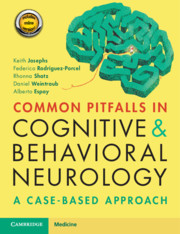Book contents
- Common Pitfalls in Cognitive and Behavioral Neurology
- Common Pitfalls in Cognitive and Behavioral Neurology
- Copyright page
- Dedication
- Contents
- Diseases Discussed in the Book
- Preface
- Acknowledgements
- Abbreviations
- Part 1 Missing the Diagnosis Altogether
- Part 2 Misidentifying the Impaired Cognitive Domain
- Part 3 Missing Important Clues in the History
- Part 4 Failure of Pattern Recognition
- Part 5 Difficult-to-Characterize Cognitive/Behavioral Disorders
- Part 6 Clinical Findings That Are Subtle
- Part 7 Misinterpreting Test Results
- Case 31 Does a Positive Amyloid Scan Always Mean Alzheimer Disease?
- Case 32 Herpes Encephalitis Recurrence?
- Case 33 Refractory “VGKC Encephalopathy”
- Case 34 sCJD with Negative 14–3–3?
- Case 35 You Have Been Diagnosed with Alzheimer Disease; Is That It?
- Part 8 Attributing Findings to a Known or Suspected Disorder
- Part 9 Missing Radiographic Clues
- Part 10 Management Misadventures
- Index
- Plate Section (PDF Only)
- References
Case 31 - Does a Positive Amyloid Scan Always Mean Alzheimer Disease?
from Part 7 - Misinterpreting Test Results
Published online by Cambridge University Press: 03 November 2020
- Common Pitfalls in Cognitive and Behavioral Neurology
- Common Pitfalls in Cognitive and Behavioral Neurology
- Copyright page
- Dedication
- Contents
- Diseases Discussed in the Book
- Preface
- Acknowledgements
- Abbreviations
- Part 1 Missing the Diagnosis Altogether
- Part 2 Misidentifying the Impaired Cognitive Domain
- Part 3 Missing Important Clues in the History
- Part 4 Failure of Pattern Recognition
- Part 5 Difficult-to-Characterize Cognitive/Behavioral Disorders
- Part 6 Clinical Findings That Are Subtle
- Part 7 Misinterpreting Test Results
- Case 31 Does a Positive Amyloid Scan Always Mean Alzheimer Disease?
- Case 32 Herpes Encephalitis Recurrence?
- Case 33 Refractory “VGKC Encephalopathy”
- Case 34 sCJD with Negative 14–3–3?
- Case 35 You Have Been Diagnosed with Alzheimer Disease; Is That It?
- Part 8 Attributing Findings to a Known or Suspected Disorder
- Part 9 Missing Radiographic Clues
- Part 10 Management Misadventures
- Index
- Plate Section (PDF Only)
- References
Summary
This 72-year-old left-handed man presented with a 3-year history of cognitive and behavioral decline. His wife first noticed that he was slower to respond and make decisions. He daydreamed and often lost his focus, requiring that comments be repeated. Worsening of symptoms prompted a neurological evaluation within a year of symptom onset. The neurological exam was reported as unremarkable. The score on the Montreal Cognitive Assessment (MoCA) was 24/30 due to impairments in trail making, cube and clock drawings, phonemic fluency, and delayed recall (he recalled three words freely and recognized the other two when multiple choices were given). Brain MRI showed diffuse atrophy. Florbetapir beta-amyloid PET scan was positive by clinical read (Figure 31.1). This led to a diagnosis of Alzheimer disease.
- Type
- Chapter
- Information
- Common Pitfalls in Cognitive and Behavioral NeurologyA Case-Based Approach, pp. 99 - 102Publisher: Cambridge University PressPrint publication year: 2020



